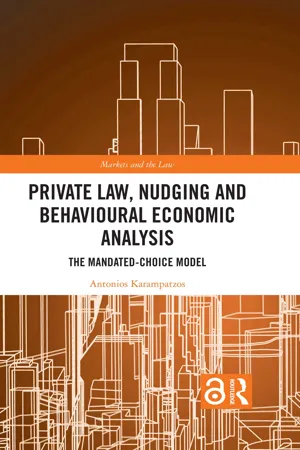
Private Law, Nudging and Behavioural Economic Analysis
The Mandated-Choice Model
- 174 pages
- English
- ePUB (mobile friendly)
- Available on iOS & Android
Private Law, Nudging and Behavioural Economic Analysis
The Mandated-Choice Model
About this book
Offering a fresh perspective on "nudging", this book uses legal paternalism to explore how legal systems may promote good policies without ignoring personal autonomy.
It suggests that the dilemma between inefficient opt-in rules and autonomy restricting opt-out schemes fails to realistically capture the span of options available to the policy maker. There is a third path, namely the 'mandated-choice model'. The book is mainly dedicated to presenting this model and exploring its great potential. Contract law, consumer protection, products safety and regulatory problems such as organ donation or excessive borrowing are the setting for the discussion. Familiarising the reader with a hot debate on paternalism, behavioural economics and private law, this book takes a further step and links this behavioural law and economics discussion with philosophical considerations to shed a light on modern challenges, such as organ donation or consumers protection, by adopting an openly interdisciplinary approach.
The book will be of interest to students and scholars of contract law, legal systems, behavioural law and economics, and consumer law.
The Open Access version of this book, available at http://www.taylorfrancis.com, has been made available under a Creative Commons Attribution-NonCommercial-NoDerivatives (CC BY-NC-ND) 4.0 license.
Frequently asked questions
- Essential is ideal for learners and professionals who enjoy exploring a wide range of subjects. Access the Essential Library with 800,000+ trusted titles and best-sellers across business, personal growth, and the humanities. Includes unlimited reading time and Standard Read Aloud voice.
- Complete: Perfect for advanced learners and researchers needing full, unrestricted access. Unlock 1.4M+ books across hundreds of subjects, including academic and specialized titles. The Complete Plan also includes advanced features like Premium Read Aloud and Research Assistant.
Please note we cannot support devices running on iOS 13 and Android 7 or earlier. Learn more about using the app.
Information
Part B
EU private law and possible scope of application of the mandated-choice model under a Behavioral Economic Analysis of Law (BEAL) approach
4 The withdrawal right pursuant to Directive 2011/83/EU and the application of the mandated-choice model
I. Directive 2011/83/EU on Consumer Rights1
II. The withdrawal right5
1. The withdrawal right justified by virtue of BEAL
Table of contents
- Cover
- Half Title
- Series Page
- Title Page
- Copyright Page
- Table of Contents
- Preface
- About the author
- Part A Behavioral economic analysis of law, nudge theory, and freedom of choice
- Part B EU private law and possible scope of application of the mandated-choice model under a Behavioral Economic Analysis of Law (BEAL) approach
- Index